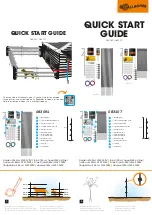
17
STEP-BY-STEP
GUIDE
0800 003 006
/
boundaryline.co.nz
PAINTING YOUR WALL
Please make sure you do not carry out any painting on your new wall until wal is completely dry! If
the wall is not completely dry you will have a risk of mould growth, you should wait a minimum of 36
hours for the wall to completely dry from any rain.
Please make sure all joins or potential moisture traps are sealed with a good quality MS silicone
Sealant. The centre join is the main join that needs to be completely sealed from any moisture.
WE RECOMMEND YOU PAINT YOUR WALL WITHIN 90 DAYS OF INSTALLATION.
We recommend that you use Dulux Weather Shield x10 or Dulux Timbercryll or a similar self priming premium brand
of exterior grade paint. A base primer is not required as long as the paint being applied is self priming and suitable for
untreated fibre cement/masonry substrates.
Dulux product spec pages:
hhttp://www.duspec.co.nz/duspec/file/NZDD1268.pdf or http://www.duspec.co.nz/duspec/file/NZDD0789.pdf
EXTERIOR PAINT
APPLICATION
!
IMPORTANT
The metal surfaces to be painted mus be clean, dry and free of contaminants.
Lightly scuff/rub dwon all Metal and Primed components with a 3M Scotch Bright pad prior to the application of paint.
Scotch Bright pads are available from most paint stores.
NOTE: -
The light key this gives won`t be visible but it is effective!
Prepare the surface by ensuring that the Fibre Cement Panels are clean,
dry and free of contaminants. This can be achieved by means of a brush
down with a stiff brush or rubbing lightly with a ‘Scotch Bright’ pad.
Two coats of paint are required.
We recommend applying the first coat with a roller. Cut in the sections that
the roller missed with a brush prior to applying the second coat. Let the first
‘cutting in’ dry and apply a second ‘cutting in’ coat prior to the second and
final roller coat.
On a large job a spray application may be justified. Please see the paint
manufacturer for advice on spray application.
SURFACE PREPARATION –
POSTS, TRIMS & POST TOPS
SURFACE PREPARATION –
PANELS
APPLICATION PROCEDURE






















